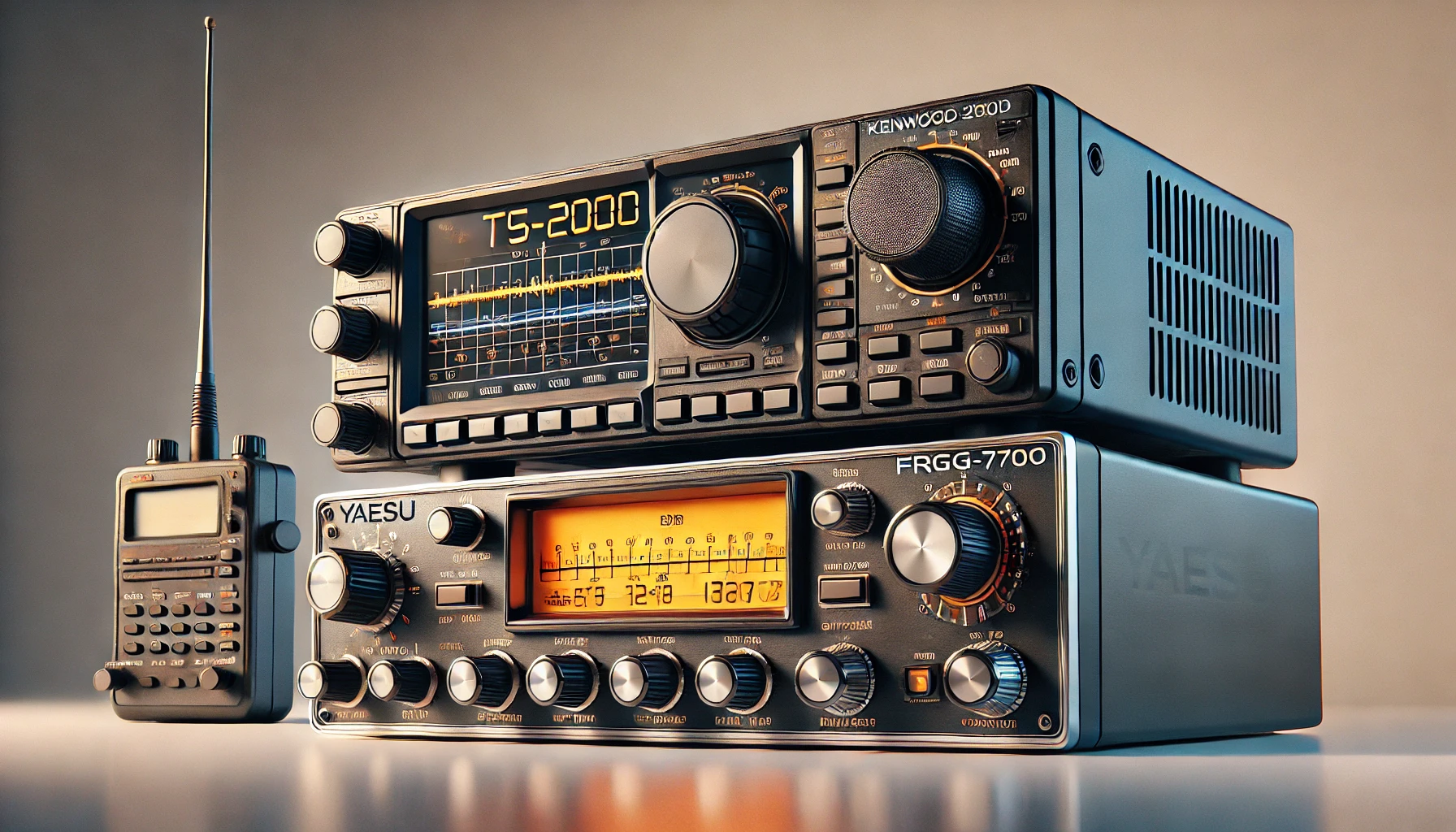Introduction: Kenwood TS2000 vs Yaesu FRG 7700 – Which One Wins?
When it comes to amateur radio, two names consistently stand out for their high-performance transceivers: Kenwood TS2000 and Yaesu FRG 7700. Both of these models have earned respect and a dedicated following due to their robust features and reliable performance in a variety of conditions. However, selecting between the Kenwood TS2000 and the Yaesu FRG 7700 requires a deeper look into the specifications, features, and overall value each unit brings to the table.
In this comparison, we will explore the kenwood ts2000 vs yaesu frg 7700, weighing their pros and cons, and helping you make an informed decision based on your specific needs in the world of amateur radio.
Kenwood TS2000 vs Yaesu FRG 7700: Overview of Key Features
Kenwood TS2000 Overview
The Kenwood TS2000 is a versatile and powerful all-mode transceiver designed to operate on HF, VHF, and UHF bands. It has earned a reputation as one of the most capable multi-band radios on the market, offering a wide range of features for both beginner and experienced ham radio operators.
Key Features of the Kenwood TS2000:
- HF, VHF, and UHF Bands: Covers 160 meters to 70 cm, including 2m and 70cm bands.
- Multi-mode Support: Supports AM, FM, SSB, and CW modes.
- Advanced DSP Processing: Utilizes Digital Signal Processing (DSP) to improve signal clarity and reduce noise.
- Large Color Display: A 3.5-inch color display that shows frequency, mode, and other relevant information.
- Expandable Options: Offers various options for digital modes and external devices, making it an adaptable choice for various operations.
Yaesu FRG 7700 Overview
On the other hand, the Yaesu FRG 7700 is an older but still highly regarded receiver. This model was introduced as a high-performance receiver with a focus on quality and reliability. While it is primarily a receiver, it offers excellent reception across multiple bands and is favored by those who want a solid, dependable machine for monitoring HF bands.
Key Features of the Yaesu FRG 7700:
- Coverage Across HF Bands: The Yaesu FRG 7700 operates on the 160m to 10m bands, allowing users to enjoy a broad listening experience.
- Analog Tuning Dial: Features an analog tuning dial for manual tuning, which some operators prefer for its tactile feedback.
- Variable Bandwidth Control: This feature enables operators to filter out unwanted signals for a clearer reception.
- Rugged Build: Known for its durability and longevity, the Yaesu FRG 7700 was built to withstand the rigors of both home and mobile operations.
Kenwood TS2000 vs Yaesu FRG 7700: Performance Comparison
Receiver Sensitivity and Selectivity
When comparing the kenwood ts2000 vs yaesu frg 7700 in terms of receiver performance, both radios excel in different areas.
- Kenwood TS2000: Thanks to its advanced DSP technology, the Kenwood TS2000 offers excellent sensitivity and selectivity, even in crowded conditions. Its ability to filter noise and reduce interference is a notable advantage, making it ideal for use in environments with high levels of electromagnetic interference.
- Yaesu FRG 7700: The Yaesu FRG 7700, while not as advanced in terms of DSP technology, still delivers superb sensitivity. It is capable of picking up weak signals with ease and providing clear audio. The Yaesu FRG 7700 is especially strong in single-sideband (SSB) reception, making it an excellent choice for those who enjoy listening to amateur transmissions.
Transmitter Performance
- Kenwood TS2000: The Kenwood TS2000 is a full-fledged transceiver, meaning it has both transmitting and receiving capabilities. Its transmitter is well-known for its clean output and ability to deliver stable signals across a wide range of frequencies. Whether you’re operating in AM, FM, or SSB mode, the TS2000 ensures that your transmissions are clear and effective.
- Yaesu FRG 7700: Unlike the Kenwood TS2000, the Yaesu FRG 7700 is a receiver only. This means that if you need to transmit, you will need a separate transmitter. However, as a dedicated receiver, the Yaesu FRG 7700 offers exceptional reception performance with low noise levels and great dynamic range.
Kenwood TS2000 vs Yaesu FRG 7700: User Interface and Ease of Use
Kenwood TS2000 User Interface
The Kenwood TS2000 is designed with modern hams in mind. Its large, full-color display offers plenty of information at a glance, including frequency, mode, and signal strength. The interface is relatively intuitive, and users can access various settings through the menu system. While it has a lot of features, it is still user-friendly, especially with the built-in digital processing for noise reduction and filtering.
Yaesu FRG 7700 User Interface
The Yaesu FRG 7700 has a more traditional, straightforward interface. With an analog dial and simple controls, it’s perfect for those who enjoy the tactile feedback of manual tuning. However, it lacks some of the modern digital features found in the Kenwood TS2000, making it slightly more challenging to use for advanced features. That being said, the simplicity and ease of use are preferred by operators who appreciate analog technology.
Kenwood TS2000 vs Yaesu FRG 7700: Durability and Build Quality
Kenwood TS2000 Build Quality
The Kenwood TS2000 is built with durability in mind. It’s a robust unit that can withstand the demands of frequent use. Its solid construction ensures that it performs well over time, with minimal maintenance required. However, its weight and size make it less portable compared to the Yaesu FRG 7700, especially for users who need a mobile setup.
Yaesu FRG 7700 Build Quality
The Yaesu FRG 7700 is also known for its durability. While it’s not as modern in design as the Kenwood TS2000, the Yaesu FRG 7700 is still a reliable receiver that will last for many years with proper care. Its all-metal case offers robust protection, and the unit can take a few knocks without suffering significant damage. Additionally, because it is lighter and smaller than the Kenwood TS2000, it is more portable for users who need a compact receiver.
Kenwood TS2000 vs Yaesu FRG 7700: Price and Value
Kenwood TS2000 Price
The Kenwood TS2000 is generally priced higher than the Yaesu FRG 7700. This higher price reflects its advanced features, including DSP technology, multi-band capability, and transmitting capabilities. If you’re looking for an all-in-one transceiver with modern features, the Kenwood TS2000 is a great investment, though it may not be the most affordable option for beginners.
Yaesu FRG 7700 Price
The Yaesu FRG 7700 is typically more budget-friendly, making it an excellent option for those who only need a high-quality receiver. For amateur radio operators who don’t need the transmitting capabilities of the Kenwood TS2000, the Yaesu FRG 7700 offers great value for its price, especially for those who appreciate the simplicity of analog controls.
Kenwood TS2000 vs Yaesu FRG 7700: Which One is Right for You?
Choosing the Right Option for Your Needs
The choice between kenwood ts2000 vs yaesu frg 7700 largely depends on your specific needs as a radio operator:
- Kenwood TS2000 is perfect for those looking for an all-in-one solution that offers both transmitting and receiving capabilities across multiple bands. It’s ideal for operators who require modern features like DSP, a large color display, and multi-band capabilities.
- Yaesu FRG 7700 is better suited for individuals who want a dedicated receiver for listening to transmissions across HF bands. It is a more budget-friendly option, and its analog tuning dial will appeal to those who enjoy the tactile experience of manual operation.
Conclusion: Kenwood TS2000 vs Yaesu FRG 7700 – Final Verdict
Both the Kenwood TS2000 and Yaesu FRG 7700 have their strengths and are highly regarded in the amateur radio community. The Kenwood TS2000 shines in its versatility, modern features, and all-in-one design, while the Yaesu FRG 7700 excels as a simple yet highly effective receiver.
Ultimately, the choice between the two comes down to your specific requirements—whether you’re looking for a comprehensive transceiver or a dedicated receiver.




